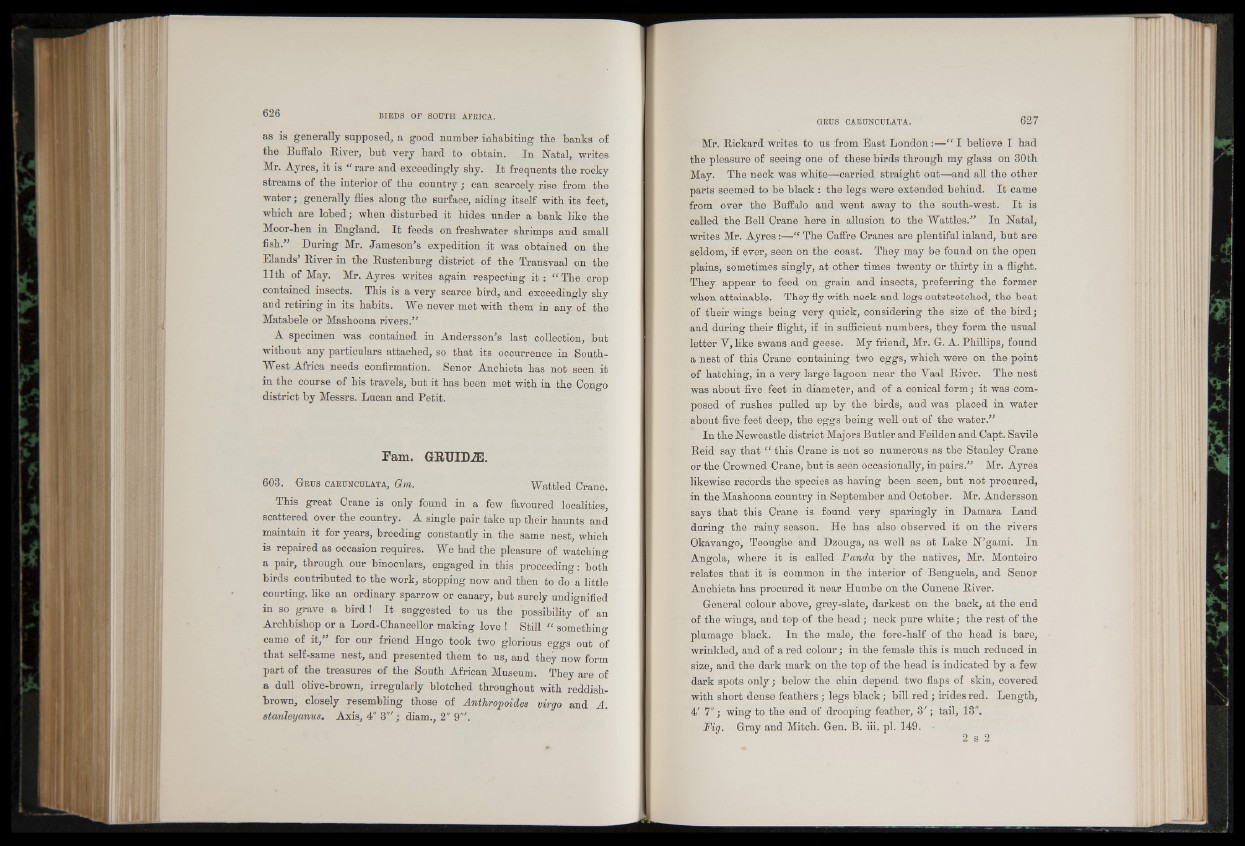
as is generally supposed, a good number inhabiting the banks of
the Buffalo River, but very hard to obtain. In Natal, writes
Mr. Ayres, it is “ rare and exceedingly shy. It frequents the rocky
streams of the interior of the country ; can scarcely rise from the
water; generally flies along the surface, aiding itself with its feet,
which are lobed; when disturbed it hides under a bank like the
Moor-hen in England. It feeds on freshwater shrimps and small
fish. During Mr. Jameson’s expedition it was obtained on the
Elands River in the Rustenburg district of the Transvaal on the
11th of May. Mr. Ayres writes again respecting it : “ The crop
contained insects. This is a very scarce bird, and exceedingly shy
and retiring in its habits. We never met with them in any of the
Matabele or Mashoona rivers.”
A specimen was contained in Andersson’s last collection, but
without any particulars attached, so that its occurrence in South-
West Africa needs confirmation. Senor Anchieta has not seen it
in the course of his travels, but it has been met with in the Congo
district by Messrs. Lucan and Petit.
Fam. GRUID2E.
603. G rus carunculata, Gm. Wattled Crane.
This great Crane is only found in a few favoured localities,
scattered over the country. A single pair take up their haunts and
maintain it for years, breeding constantly in the same nest, which
is repaired as occasion requires. We had the pleasure of watching
a pair, through our binoculars, engaged in this proceeding: both
birds contributed to the work, stopping now and then to do a little
courting, like an ordinary sparrow or canary, but surely undignified
in so grave a bird ! It suggested to us the possibility of an
Archbishop or a Lord-Chancellor making love ! Still 1 something
came of it,” for our friend Hugo took two glorious eggs out of
that self-same nest, and presented them to us, and they now form
part of the treasures of the South African Museum. They are of
a dull olive-brown, irregularly blotched throughout with reddish-
brown, closely resembling those of Anthropoicles virgo and A.
stanleyanus. Axis, 4" 3"'; diam., 2" 9"'.
Mr. Rickard writes to us from East London:—“ I believe I had
the pleasure of seeing one of these birds through my glass on 30th
May. The neck was white—carried straight out—and all the other
parts seemed to be black : the legs were extended behind. It came
from over the Buffalo and went away to the south-west. I t is
called the Bell Crane here in allusion to the Wattles.” In Natal,
writes Mr. Ayres:—“ The Caffre Cranes are plentiful inland, but are
seldom, if ever, seen on the coast. They may be found on the open
plains, sometimes singly, at other times twenty or thirty in a flight.
They appear to feed on grain and insects, preferring the former
when attainable. They fly with neck and legs outstretched, the beat
of their wings being very quick, considering the size of the bird;
and during their flight, if in sufficient numbers, they form the usual
letter Y, like swans and geese. My friend, Mr. G. A. Phillips, found
a nest of this Crane containing two eggs, which were on the point
of hatching, in a very large lagoon near the Yaal River. The nest
was about five feet in diameter, and of a conical form; it was composed
of rushes pulled up by the birds, and was placed in water
about five feet deep, the eggs being well out of the water.”
In the Newcastle district Majors Butler and Feilden and Capt. Savile
Reid say that “ this Crane is not so numerous as the Stanley Crane
or the Crowned Crane, but is seen occasionally, in pairs/'’ Mr. Ayres
likewise records the species as having been seen, but not procured,
in the Mashoona country in September and October. Mr. Andersson
says that this Crane is found very sparingly in Damara Land
during the rainy season. He has also observed it on the rivers
Okavango, Teoughe and Dzouga, as well .as at Lake N’gami. In
Angola, where it is called Panda by the natives, Mr. Monteiro
relates that it is common in the interior of Benguela, and Senor
Anchieta has procured it near Humbe on the Cunene River.
General colour above, grey-slate, darkest on the back, at the end
of the wings, and top of the head ; neck pure white; the rest of the
plumage black. In the male, the fore-half of the head is bare,
wrinkled, and of a red colour; in the female this is much reduced in
size, and the dark mark on the top of the head is indicated by a few
dark spots only; below the chin depend two flaps of skin, covered
with short dense feathers ; legs black; bill red; iridesred. Length,
4' 7"; wing to the end of drooping feather, 3 '; tail, 13".
Fig. Gray and Mitch. Gen. B. iii. pi. 149.